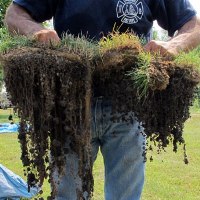This article originally appeared on www.mariasfarmcountrykitchen.com.
 The summer season always brings to mind bright green lawns and idyllic images of children running barefoot through the grass. However, lawns are a quintessentially American phenomenon, and when you begin to “dig” deeper into lawn care in America, the picture is not so pretty.
The summer season always brings to mind bright green lawns and idyllic images of children running barefoot through the grass. However, lawns are a quintessentially American phenomenon, and when you begin to “dig” deeper into lawn care in America, the picture is not so pretty.
Lawn turf covers more than 40 million acres of land—more than any commercial crop. To keep those lawns bright green and bug free, Americans use 90 million pounds of fertilizer and 78 million pounds of pesticides each year. Of the most commonly used lawn pesticides, many are linked with cancer or carcinogenicity, birth defects, reproductive effects, liver or kidney damage, neurotoxicity, and disruption of the endocrine system.
The fertilizers used on lawns often contain high levels of phosphorus and nitrogen. While this makes the grass bright green, chemicals from the fertilizer leach into rivers and streams, contaminate drinking water, and cause ecological havoc. Lawns also consume massive amounts of water, much more than agricultural crops. The Environmental Protection Agency estimates that 7.8 billion gallons, or 30 percent of the water we consume daily in the United States, is devoted to outdoor use such as watering lawns. Then there’s the carbon footprint of the lawn: Gas-powered lawn and garden equipment give off toxic exhaust and greenhouse gases and emit as much pollution per hour as 11 cars.
With statistics like this, it was essential that the Rodale Institute research team begin to look more closely at this field to see what we could learn. Working with James Sotillo, arborist and consultant from Ecological Landscape Management, we designed a trial to compare the use of compost tea with using chemical fertilizer on sod. Over the course of one month, three applications of compost tea were applied to three raised beds; fertilizer was applied to another three beds.
The results were astounding, and we’ll be publishing a paper later this year. But to share a few highlights of what we learned:
- In the beds treated with compost tea, root length was an average of two to four times longer than in the beds treated with chemical fertilizer, making those areas more resistant to drought and other environmental stresses.
- Grass will go dormant and turn brown when it is stressed. This allows the plant to focus resources on the roots. In our study, we found that the amount of dormant grass was much higher in the fertilized beds, whereas no dormant grass could be found in the compost tea–treated beds.
- Thatch length decreased in beds treated with compost tea, proving that there is less grass dying out when it is treated with biology rather than with chemical treatments.
These results show that by utilizing compost tea instead of inorganic, chemical-based fertilizers, we are able to cultivate healthy soil while still ensuring that our lawn spaces thrive organically. Please keep an eye on rodaleinstitute.org as we begin to share more results from this study. We look forward to helping you convert your lawn to organic.
For more updates on Rodale Institute’s research and programming, follow us on Facebook, Instagram, and Twitter.
